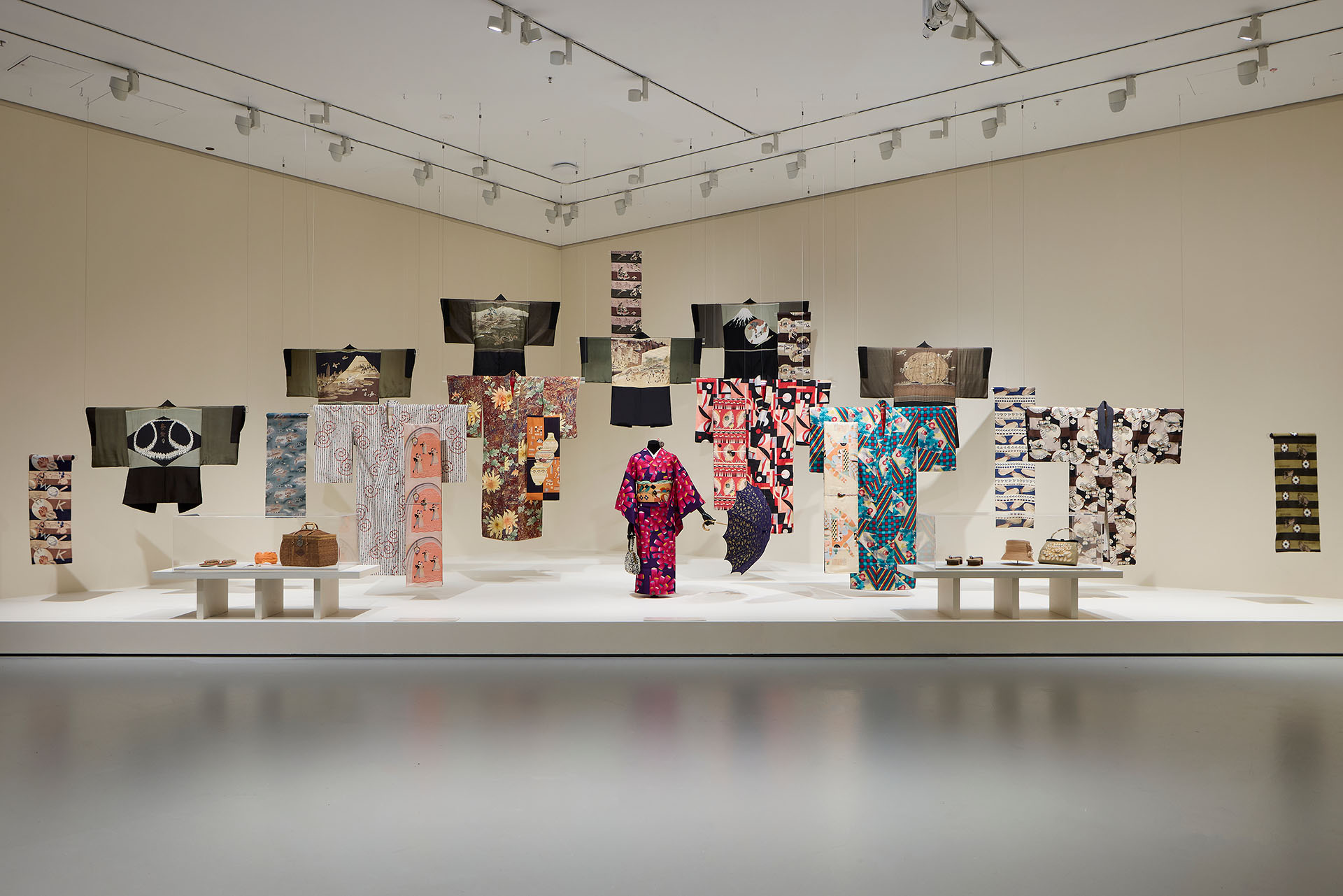Describe and Analyse
Select one kimono and answer the questions below:
- 何(なに)が見(み)えますか? What can you see?
Use nouns and adjectives to describe the patterns, colours, and objects on the kimono.
Try writing a list or full sentences.
Example:
[花(はな)とちょうちょ]が見(み)えます。
I can see flowers and butterflies.
- どんな人(ひと)がこの着物(きもの)を着(き)ていますか?
Who do you think would wear this kimono?
- この着物(きもの)はどこで着(き)ますか?
Where might a person wear this kimono?
Compare and Contrast
Choose two kimono to compare. You can compare colours, patterns, style or mood. Write three sentences using the structure:
A よりB のほうが [adjective] です。 (B is more [adjective] than A.)
Examples:
- この着物(きもの) より あの着物(きもの) のほうが かわいいです。
That kimono is cuter than this kimono.
- 男(おとこ)の人(ひと)の着物(きもの)より 女(おんな)の人(ひと)の着物(きもの)のほうが 色(いろ)があざやかです。
Women’s kimono are more colourful than men’s kimono.
- 浴衣(ゆかた)より 振袖(ふりそで)のほうが 敷居(しきい)が高(たか)くて、特別(とくべつ)な日(ひ)に着(き)ます
A furisode is more formal than a yukata and is worn on special occasions.
Shopping
Imagine you are on a shopping excursion. Choose three objects you would like to ‘purchase’ and write down your reasons why in Japanese. You might even like to compare several items using より … のほうが structure.
Example:
暑(あつ)い日(ひ)に使(つか)えるから、この日傘(ひがさ)を買(か)います。
I will buy this parasol because I can use it on sunny days.
Season Spotting Challenge in the Gallery
As you explore the gallery spaces, look closely at the patterns, colours and details on the garments and objects on display.
- Can you find 3 symbols that represent a season? Look closely at the symbols of your choice and copy the design with a simple sketch. Read the label to learn about what the symbol represents and write it in English or Japanese next to your sketch.
- Try to find both traditional motifs and more modern or unexpected ones. Can you find a motif you’ve never seen before? What season do you think it belongs to?
- Share your favourite seasonal motif with a peer or with the class. What do you think it means? Why do you think this motif represents that season?
Diary Entry
Write a diary entry of a day in the life of the person wearing one of the kimono you saw in the exhibition.
Consider the following:
- Where did you go?
- What did you do?
- Who did you go with?
- What did you eat and drink?
- How was it?
Example:
侍(さむらい) の日記 (にっき):
Diary of a Samurai:
今日は花見(はなみ)に行(い)きました。
Today I went to see the cherry blossoms.
青(あお)の着物(きもの)を着(き)て、友達(ともだち)と川(かわ)のそばで会(あ)いました。
I wore a blue kimono and met my friends by the river.
おにぎりを食(た)べて、お茶(ちゃ)を飲(の)みました。
We ate rice balls and drank tea.
とても楽(たの)しい一日(いちにち)でした。
It was a very fun day.
Design a Kimono-Inspired Seasonal Outfit
Japanese kimono often reflect the beauty of nature and the changing seasons. Think about the season you were born in, and design a kimono-inspired outfit that reflects your birth season and personality!
Sketch a simple kimono design based on the season of your birth. Think about what makes that season special:
- Nature: What flowers, animals, or colours remind you of that time of year?
- Festivals: Are there seasonal events or celebrations you enjoy?
- Food: What food or drinks do you like during that season?
- Activities: What do you enjoy doing during that time?
Include at least 3 motifs and symbols that remind you of your season in your design. You can mix in symbols you’ve found from around the gallery, and things that represent you, like a favourite animal, hobby, or interest.
When you are ready, show your design to a classmate and let them guess which season your kimono represents and when you were born. Then, switch roles.
Complete the following sentence in Japanese to describe your kimono design:
わたしの着物(きもの) は[season]です。[motif/symbol]と[motif/symbol]があります。
My kimono is of [season]. It has [motif/symbol] and [motif/symbol].
Example:
わたしの着物(きもの) は夏用(なつよう) です。すいかとひまわりがあります。
My kimono is for summer. It has watermelons and sunflowers on it.
Complete Your Kimono Design
Contemporary kimono designers draw on personal experiences, emotions, and cultural themes to create unique garments. Now it’s your turn to build on the seasonal kimono design you’ve started and add more design elements that reflect your own story, interests, and background.
Step 1: Design and Sketch Your Outfit
Think about:
- What patterns, colours, or symbols can you add to represent your personality or heritage?
- Is your design inspired by a special memory, tradition, or interest?
- Would your outfit be more traditional, or more modern like Shigemune’s?
- Add shoes, bags, and other accessories to complete your look.
Add your design elements to your sketch and label the features that are important to you.
Step 2: Describe Your Design & Interview a Classmate
Use simple Japanese to describe your outfit and interview your classmate about theirs. Record each other’s responses using short sentences in Japanese and share with the class.
Practice using the following Japanese sentences:
- Person A: どんなもようがありますか?
What kind of pattern is on yours?
- Person B: わたしの着物(きもの) は[colours, adjectives]です。
My kimono is…
- このもようは[…]を表(あらわ)しています。
This pattern represents…
Example 1:
わたしの着物(きもの)は青(あお)と白(しろ)です。
My kimono is blue and white.
このもようは夏(なつ)と海(うみ)を表(あらわ)しています。
This pattern represents summer holidays and the sea.
Example 2:
わたしの着物(きもの)はカラフルでかっこいいです。
My kimono is colourful and cool.
このもようはバスケットボールの楽しさを表(あらわ)しています。
This pattern represents the fun of basketball.
Create a kimono-inspired garment design and write a short profile of it’s wearer in Japanese. This wearer can be for a fictional character, a future version of yourself, or someone you admire.
Include:
Who the kimono-inspired garment is for. (age, personality, interests)
What the garment expresses or symbolises.
When/Where the person might wear it (special event? everyday life?).
You can use the following Japanese sentences:
この着物(きもの) は[person]のためにデザインしました。(This kimono is designed for [person])
[interests, passion] が好(す)きです。性格(せいかく) は[personality]です。(This person’s interest/ passion is…., their personality is….)
[occasion]の時(とき)に着(き) ます。(It is worn on [occasion])
[theme]をテーマにしています。(It is themed around [theme])
Example:
この着物(きもの)は[K-POPアイドル]のためにデザインしました。
This kimono is designed for a K-pop idol.
[音楽(おんがく)とダンス]が好(す)きです。性格(せいかく)は[明(あか)るくて元気(げんき)]です。
They like music and dancing. Their personality is cheerful and energetic.
[ライブ]の時(とき)に着(き)ます。
It is worn at live concerts.
[音符(おんぷ)とネオンの色(いろ)]をテーマにしています。
It is themed around music notes and neon colours.


